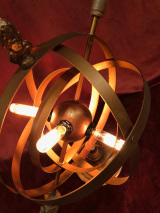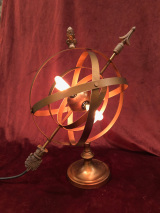ILLUMINATED ARMILLARY GLOBE - COPPER HUE
SKU:
$169.00
$169.00
Unavailable
per item
A warm coppery glow shines from the rings of this stately piece, featuring four 25w Edison-style tube bulbs arranged satellite-style around a sphere. An in-line rotary dial rheostat switch controls the level of light, from quite bright to just barely visible.
This illuminated object is perfect for a den, bedroom, living room or bookcase. It casts a very warm candlelight-like color, and can be bright enough to read by. The concentric rings are adjustable, and the sphere may be turned to adjust the angle of the tube bulbs.
It measures 19.5" tall, 17" wide (including the arrow head and tail), 12" round, and is made of an all-metal construction. All electrical materials are UL approved, and all connections are carefully tested for safety and durability. The bulbs are candelabra-style squirel-cage filament, 3.25" in length.
The armillary sphere was invented hundreds of years ago as a tool for modeling the position and motion of a heavenly body. The rings would be adjusted in order to trace the path of the stars. Some credit its invention to a Greek named Eratosthenos. Others have said that Chinese or other Greek scholars invented it. Regardless of its inventor, the armillary sphere is one of the oldest astronomical instruments in the world.
This illuminated object is perfect for a den, bedroom, living room or bookcase. It casts a very warm candlelight-like color, and can be bright enough to read by. The concentric rings are adjustable, and the sphere may be turned to adjust the angle of the tube bulbs.
It measures 19.5" tall, 17" wide (including the arrow head and tail), 12" round, and is made of an all-metal construction. All electrical materials are UL approved, and all connections are carefully tested for safety and durability. The bulbs are candelabra-style squirel-cage filament, 3.25" in length.
The armillary sphere was invented hundreds of years ago as a tool for modeling the position and motion of a heavenly body. The rings would be adjusted in order to trace the path of the stars. Some credit its invention to a Greek named Eratosthenos. Others have said that Chinese or other Greek scholars invented it. Regardless of its inventor, the armillary sphere is one of the oldest astronomical instruments in the world.
1 available









